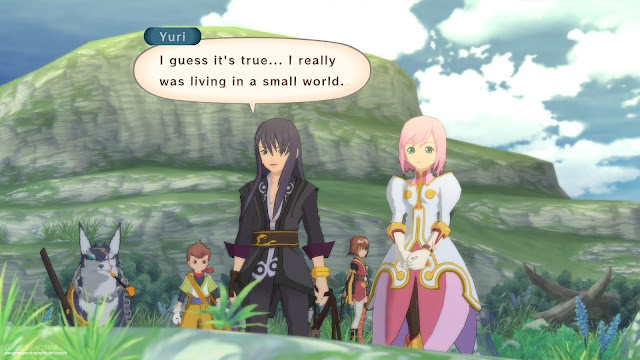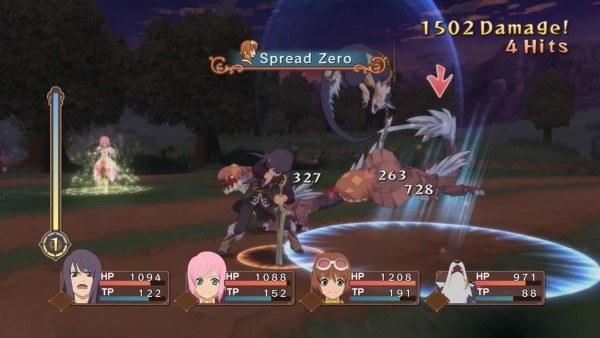Feature by Harvard L.
The Tales series is by many regards Bandai Namco’s answer to Square Enix’s Final Fantasy. It’s a JRPG series with epic scope and a long line of mainstream titles connected more by common elements than plot or character, which is beloved by its hardcore Japanese fans, as well as a few dedicated Western players who stomached the convoluted localisation issues. In PAL regions the first game to arrive was the fifth one – Tales of Symphonia for the Gamecube (the PlayStation 2 version was Japan only), and then the series headed to the PSP for Eternia (#2), then GBA for Phantasia (#1), then Xbox 360 for Vesperia (#9), 3DS for Abyss (#7), Vita for Hearts (#10) and then PlayStation 3 for Graces (#11). Things have mellowed out a bit with the latest titles getting multiplatform releases and with the re-release of Symphonia and now Vesperia, so I figured it was a good time to stop viewing the games as interesting singular entities and try analysing them as a semi-cohesive lineage.
The immediate commonalities between the games are largely superficial. They all have colourful anime art styles, all have big parties of diverse characters and an action combat system built upon special moves. They have streamlined health items called Apple Gels that restore a percentage of your health instead of a flat number (a stroke of genius, really) and Magic Lens, which allows you to see the stats, strengths and weaknesses of an enormous, staggering bestiary. But the games are all set in different universes without any sort of continuity, and there are no thematic connections like the crystals in early Final Fantasy or the heroes in Dragon Quest.
The only major plot element that players have come to expect from the Tales series is deconstruction. Every single one of the Tales games takes aim at established JRPG tropes, re-examining them from a new lens or calling its validity into question. It’s a process so well documented that fans have figured out that at roughly the halfway mark, there is without fail a giant plot twist that reshapes the interpretation of the whole story. But if the twist itself is something to be expected, is it a twist at all? This and many more problems plague the concept of writing narratives as “deconstruction” and I would argue that Tales of Vesperia navigates a veritable minefield and pulls off a narrative which deserves to be celebrated.
This is no easy feat, either – the JRPG genre is hard to deconstruct because it doesn’t have the pre-existing tropes that players have already internalised. It’s not like first-person shooters or slasher horror, genres which have similar plotlines and stock characters because their target audience isn’t there for narrative. JRPGs instead tend to have unique, unpredictable, convoluted plots that keep the player guessing until the final moment – plots which are often referred to as deconstructive because they diverge wildly from player expectations. From that description alone, I’ve heard people refer to Final Fantasy IV, VI, VII, VIII, X, XII, XIII and XV all as deconstructions in some way or another. Now if the flagship JRPG franchise has more than half its mainline titles offering up the unconventional, what is there for the Tales series to work with?
In Vesperia’s case, it does this by spending the first act of the game establishing a perfectly “ordinary” game world. On Terca Lumireis, people live in cities shielded by magical orbs called “blastia”, which ward off hostile monsters and enable more convenient living. The game’s world has two main factions – the Empire, and the Trade Guilds. The Empire holds an authoritarian regulation on all blastia and thus, are able to decide where people live and what conditions they endure. They train a class of Royal Knights to enforce law across the cities and keep monsters at bay. The Trade Guilds meanwhile are a loosely assembled group of individual businesses offering all sorts of services from monster hunting and manufacturing, to more underhanded jobs like assassination. The Guilds operate on a might-makes-right principle and exist in an uneasy coexistence with the Empire. The plot follows Yuri Lowell, an ex-knight from a low economic background, who goes on a journey to search for a rogue Guild member who stole his township’s blastia.
The game world is very conventional, setting up the opportunity for conflict and always reminding players about the scarcity of resources. The player is introduced to the main concerns rather ham-fistedly, through an introduction sequence that sees Yuri traversing to the high-class area of town, getting locked up for trespassing, being branded as a criminal and then setting out on a quest to find his childhood friend and knight, Flynn. As Yuri continues his journey, he meets up with Estelle, a Royal healer, Karol, a young guild member, Rita, a blastia researcher, Raven, a veteran and slacker, and Judith, an anti-blastia freedom fighter. (There’s also a bonus character called Patty who appears in the Definitive Edition, her character arc is mostly comic relief about being king of the pirates.)
The deconstruction in Vesperia comes from each character exhibiting a defining “heroic” characteristic, which in some way backfires spectacularly. Karol, for example, idolises the Guilds and is emblematic of the heroic optimism that fantasy characters tend to exhibit. Despite this, his young and cowardly nature leads him to get rejected and looked down upon by all the Guilds he looks up to, and he finds himself with no guidance or support in his life. He is, at least in his introduction, a failure of a hero, futilely chasing for acceptance from a society that sees no value in him.
This reading can be applied to all the characters in Tales of Vesperia. Estelle is an altruist who has spent her whole life locked up and protected in the Empire’s capital, and so she sees the world with the eyes of someone experiencing joy for the first time. Her healing artes, however, tend to cause more harm than good, and her narrative arc requires her to cope with her naivety, and the negative consequences of her well intentions. In the same vein, Flynn’s position as a Royal Knight has him travelling around the countryside and saving townsfolk from monster attacks and petty squabbles alike, but he is confronted with the fact that as a servant of the Royals he has very little agency over any immoral actions taken by the Knights or the ruling party. Yuri is the opposite side to Flynn’s coin – he is impulsive and quick to break laws if it would better serve his own sense of justice, and in doing so he leaves chaos in his wake and is tempted to push away the people who care about him.
Up until now, the Tales series has mostly played with deconstructing its primary antagonists. The games have always provided clear and rational explanations for why each game’s final boss created the conflict they did, whether it was due to the preservation of something they cared about, or a misunderstanding on the part of themselves or the hero. There are no Kefkas or Garlands in the Tales continuity – no one is evil for the sake of being evil – and the games have often pulled a plot twist to call the player out on assuming moral superiority when they shouldn’t have done so. In this narrative ethos, many characters in Vesperia – Yuri, Flynn, Estelle, Rita, Judith, maybe even Karol if he tried hard enough – could have morphed into the primary villain of someone else’s story. Each character is tested by having their failures brought in front of them, and as the game’s plot develops, take actions which jeopardise the world of Terca Lumireis – and the game’s core conflicts are as much the fault of the main party as they are of any malevolent force.
This dovetails into another problem with deconstructive writing that Vesperia avoids. The standard hero narrative is a positive one, and so questioning this structure tends to leave the game with a bitter, pessimistic tone. I’ve felt this way about lots of other games – the stories were very interesting on a cognitive level, but playing them was wearisome and it became hard to push forward when both the narrative and the gameplay combined to provide so much resistance.
Tales of Vesperia could easily have been just as oppressive – its story does go to some dark places – but it keeps its tone consistently positive through its worldbuilding and characterisation. Whereas games like Phantasy Star II want to shock players with its mutated and dying world, and games like I Am Setsuna are permeated with the looming sadness of inevitability, Vesperia has genuinely funny moments. It invests heavily into skits and cutscenes that show the game’s main cast interacting each other in humorous and heartwarming ways, even when the fate of the world is at stake. In fact, Vesperia has to be credited for taking the Tales series as a whole to a brighter place – future titles like Xillia or Berseria keep their deconstructive stories, but endeavour to offset the dramatic moments with something to put a smile on the player’s face.
Matt has been written about Tales of Vesperia and the concept of nakama – the nearly familial friendship bond that the main cast share – and it’s genuinely remarkable how the individually flawed characters overcome their limitations through the companionship of the other party members. The clearest example of this is the rivalry between Yuri and Flynn – while they are ideologically and structurally are opposites and enemies, both fondly remember their experiences growing up together and share a mutual respect for each other’s fighting ability and sense of justice. In multiple instances they are able to put aside their differences to enjoy time spent together, and this connection is what saves the two from careening down an irreversible path towards extremist ideology.
The same can be said for the friendship between Karol and Raven, Estelle and Yuri or Rita and Judith (we don’t talk about Patty). There is distinct opposition between each of these characters’ ideologies, and the story doesn’t shy away from testing the bonds either. The game may be hostile to the concept of individual heroism, whether it is through law enforcement, healing, anarchy or vigilantism, but it’s very sympathetic to the view that friendship and dialogue can achieve things far greater than either authoritarian rule or perfect meritocracy. The day-to-day moments, the adventure and the laughter overcome the most dramatic of plot twists and smoothen the most political of sentiments, and so my time with the game remained a joy even in the darkest moments.
Ultimately, Tales of Vesperia feels like a game written by people who love JRPGs, for an audience of people who love JRPGs. While it’s not the most inventive or novel, it makes a serious attempt at a grand scale narrative, smartly unpacking and rebuilding story elements that players will surely resonate with. This is a game carried by sharp writing and some of the best characterisation in the business. Even though the runtime is long, the pace is quick and the story and gameplay are both calculated to be enjoyable and not tedious. Whether you’re a genre fan or you’ve never even heard of the Tales series before, Tales of Vesperia is going to be one that you’ll remember long after playing it.
– Harvard L.
Contributor











